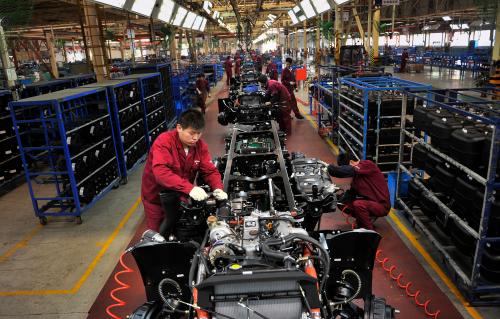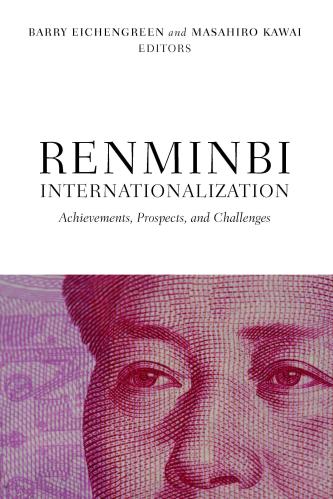Content from the Brookings Institution India Center is now archived. After seven years of an impactful partnership, as of September 11, 2020, Brookings India is now the Centre for Social and Economic Progress, an independent public policy institution based in India.
China is undergoing a difficult structural adjustment in which it is trying to transform its growth model. China has grown well for three decades based on exports and investment. But this model naturally runs out of steam over time. Now that China is the largest exporter in the world, it is difficult for its exports to grow faster than the world market. Its investment rate has risen steadily, reaching nearly 50 per cent of the economy. The problem with investing at that rate is that excess capacity starts appearing throughout the economy. Such excess capacity is now visible in housing, heavy industry, and local government infrastructure. China has not just empty apartment buildings but whole empty cities. Heavy industrial sectors such as steel and cement operate at about half of capacity. And the over-building of infrastructure is evident in the rapid run-up of local government debt that finances it. The Communist Party leadership recognizes the problem and in its Third Plenum resolution in November 2013 set out the general outlines of a plan to rein in wasteful investment. As the investment rate comes down, China can continue to grow well (in the 6 to 7 per cent range) but it needs more productivity and innovation on the supply side and more household income and domestic consumption on the demand side.
Some of the key reforms that would assist in this transformation are: (1) relaxation of the hukou registration system that restricts mobility, especially of families moving from the countryside to cities; (2) financial liberalization so that market-determined interest rates provide household savers a decent return and the cost of capital to firms and local governments is raised; (3) a market-determined exchange rate to strengthen incentives to produce for the domestic market; and (4) liberalization of service sectors, currently dominated by state enterprises and closed to foreign trade and investment. Of the Group of Twenty (G20) countries, China is the most closed to foreign investment in sectors such as financial services, telecom, logistics, and media. Other large emerging markets such as Brazil and India are much more open in these areas. Both India and the U.S. face the problem that they are relatively open to China’s rapidly rising overseas investment, while China itself remains quite closed to inward investment in key sectors.
While the breadth of China’s plan for reform is impressive, the old model and system have created powerful vested interests that oppose each individual reform so that implementation so far has been slow. Incumbent populations in major cities resist inflow of migrant families. State enterprises and local governments resist increases in the cost of capital that will make their debt burdens worse. Exporting firms and regions oppose exchange rate reform. And the big state-owned firms that have grown up behind protected walls in transport, finance, media, and telecom resist opening these sectors to domestic and international competition.
China’s ability to successfully transform its growth model will provide benefits for the regional and global economies. The slowdown in China’s investment is already a factor in declining global prices for energy and minerals. China should continue to provide demand for energy and mineral exports, just not at the pace of the past. This lesser appetite for energy and minerals should lead to less price spikes for these commodities. China should become a more diversified importer. For example, 100 million Chinese traveled abroad last year, mostly to Asia. As the middle class expands, this demand for tourist services is likely to grow rapidly. What China spends abroad on tourism counts as an “import” in the balance of payments. Another positive aspect of China’s transformation is that wages have been rising rapidly. As a result, China is losing its comparative advantage in the most labor-intensive manufacturing (footwear, clothing, electronic assembly) and these sectors are starting to move to lower-wage countries in South and Southeast Asia, boosting growth there. If China succeeds in raising domestic consumption, as it reins in investment, then its overall trade surplus – still large in the global context – should be stable or declining. Even so, it is likely to be a net supplier of capital to the world for some time. Hence its interest in new institutions such as the Asian Infrastructure Investment Bank that will enable it to recycle its surpluses.
These positive developments are not inevitable, however. It is worth noting that no authoritarian country has reached high income (with the exception of the oil-rich states, which also have small populations). It is possible that China will not be able to achieve the kind of innovation-based growth it desires without political reform, and so far the new leadership has shown no interest in such reform. The new leadership has initiated a corruption crackdown on certain individuals but has shied away from systemic reforms such as asset and income disclosure, freedom of the press, and civil society activism. A China that fails in its reform will create various problems for the world economy. If investment is reined in but consumption does not rise to replace it then China’s trade surplus will widen. In this case a market-determined exchange rate may well depreciate. Wage gains are likely to stagnate and China will fight to hang onto to its share of labor-intensive sectors. With less impressive economic gains, the leadership may well turn to nationalism to maintain its legitimacy. This is already happening to some extent and has fueled Chinese adventurism in the region.
India and the U.S. have a shared interest in encouraging China to follow through on economic reform and opening up. This can be done through each country’s bilateral dialogue with China, potential bilateral agreements such as the U.S.-China Bilateral Investment Treaty under negotiation, multilateral fora such as the G20 and the International Monetary Fund, and multilateral agreements such as an expanded Trans-Pacific Partnership.
Key topics for India-U.S. cooperation could include:
• China’s highly restrictive regime for inward investment: both India and the U.S. are disadvantaged by a regime in which Chinese firms can freely invest abroad while China’s own markets remain quite closed;
• Exchange rate management and reserve accumulation: most economists think that the Chinese exchange rate is currently close to equilibrium; however, if China’s economy slows down much further there could be pressure to depreciate the currency in a way that would be destabilizing for the Asian economy; and
• Standards for the new institutions that will be funded primarily by China (Asian Infrastructure Investment Bank and perhaps the New Development Bank established by the Brazil, Russia, India, China and South Africa – BRICS – grouping). The extent to which these new institutions adhere to global norms on environmental, social, and fiduciary standards is yet to be determined. India is a member of the new institutions, and the U.S. so far is not. Still, both countries have an interest in ensuring that the new institutions have positive value added and do not undermine global standards that have been built up through decades of experience. The new institutions should complement the existing World Bank and Asian Development Bank, not seek to supplant them.








